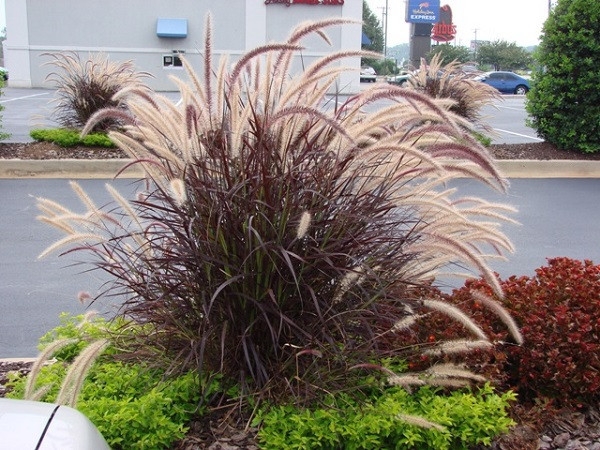Overgrown Purple Fountain Grass
Help for the Home Gardener from the Help Desk of the
UC Master Gardener Program of Contra Costa County
Client's Request: I have a very large Purple Fountain Grass plant. I'd like to thin out the plant and cut back the outer “stalks” that keep falling down, generally to “tidy it up”. How large can it grow and what care should I be giving it? Also, I have some nearby blue fescue with reddish brown stalks that I think should be “blue”. Do you think the Purple Fountain Grass might be causing this? Finally, as I've previously mentioned, I'm thinking about thinning and/or transplanting the Fountain Grass, when and how should I do that?
courtesy: calgaryhort.com
Purple Fountain Grass (Pennisetum, setaceum) is a perennial plant in Sunset Zones 8-24 (USDA zones 9 or higher) but in colder areas with heavy frost, it is usually grown as an annual. It is native to South Africa, southwestern Asia, and the Arabian peninsula. It is classified as a warm season grass, which is important to know when wanting to prune or divide the plant. It also tends to die back in the winter. It grows best in full sun, in well-draining soil, and is moderately drought tolerant. It can grow in poor soil with little care but will flourish with a little more water and fertilization. As you are aware, it can grow to about 5 feet tall and wide. It is very showy especially in the fall and offers a lovely contrast when planted with other plantings.
Answering your first question on how to thin out the plant and what to do with the falling outer “stalks” (flowers) --the best time to prune fountain grass is late winter or early spring--but be sure to prune before the grass begins to re-grow. Also avoid pruning in the fall before the plant has had time to go dormant.
It is also recommended that you wear gloves and long sleeves as grasses can be sharp and cause itching. Use sharp pruners or hedge clippers. You may need to re-sharpen them as grasses dull cutting blades. Grab the plant and tie a string or tape around it and cut straight across the plant 4-6 inches from the base. Using your hands or a tool, comb through the remaining plant to remove dead grass. If you wish to thin the plant, make small cuttings inside of the plant in several areas. The remaining grass stalks will "disappear" when the plant re-grows and will provide some support to the flowers and blades. This is an arching type of grass so some flowers will fall around the periphery of the plant and you can trim these away but again leave 4-6 inches of the blades. Here is a link to a UC article about pruning ornamental grasses: http://sonomamg.ucanr.edu/2010_Feature_Articles/Pruning_Ornamental_Grasses/.
Your second question was about the blue fescue with reddish brown stalks and whether or not the fountain grass could be causing this to happen. I could find no information in my research about fountain grass causing this problem. Browning of grass may be due to excessive watering or fertilization or the plant being root bound or excessive sunburn. It may also be the result of the fountain grass shading the blue fescue. Pruning away the brown grass is suggested as well as pruning the fountain grass so it is not shading the fescue. If the discoloration is due to a rust problem, here is an article that tells you how to manage this disease: http://ipm.ucanr.edu/PMG/r785101611.html.
Your third question about transplanting a fountain grass clump and thinning out the plant: you will want to dig up the root ball. You can best transplant and/or divide up the clump in the fall before dormancy or in the spring when the plant is beginning to re-grow. Here is a link which will give you more information: http://sacmg.ucanr.edu/files/117290.pdf.
I hope I have answered your questions and the links are helpful to you. Let us know if you have any further questions and we hope you are successful with transplanting these beautiful grasses.
Help Desk of the UC Master Gardener Program of Contra Costa County (EKP)
Note: The UC Master Gardeners Program of Contra Costa's Help Desk is available year-round to answer your gardening questions. Except for a few holidays, we're open every week, Monday through Thursday for walk-ins from 9:00 am to Noon at 75 Santa Barbara Road, 2d Floor, Pleasant Hill, CA 94523. We can also be reached via telephone: (925)646-6586, email: ccmg@ucanr.edu, or on the web at http://ccmg.ucanr.edu/Ask_Us/ MGCC Blogs can be found at http://ccmg.ucanr.edu/HortCoCo/ You can also subscribe to the Blog (//ucanr.edu/blogs/CCMGBlog/).